How To Fix Deep Scratches On A Car: A Comprehensive Guide

Fixing deep scratches on your car doesn’t have to be a daunting task. This guide from CARDIAGTECH.BIZ provides a comprehensive, step-by-step approach to effectively repair those unsightly blemishes, restoring your vehicle’s paintwork to its former glory and maintaining its value. Learn professional techniques, essential tools, and expert tips for achieving a flawless finish and ensuring long-lasting protection against future damage, all while saving money and time.
1. Understanding Deep Car Scratches and Why You Should Fix Them
Deep car scratches are more than just cosmetic imperfections; they penetrate the clear coat, base coat, and potentially even the primer, exposing the metal underneath. Ignoring these scratches can lead to rust, corrosion, and further paint damage, significantly diminishing your car’s value. Repairing deep scratches promptly prevents these issues, preserves your vehicle’s appearance, and ensures its longevity.
1.1. What Qualifies as a Deep Scratch?
A deep scratch is characterized by its ability to catch your fingernail when you run it across the surface. This indicates that the scratch has penetrated beyond the clear coat and into the underlying layers of paint.
1.2. Risks of Ignoring Deep Scratches
According to a study by the National Association of Corrosion Engineers (NACE), corrosion costs the U.S. economy over $276 billion annually. Untreated deep scratches expose bare metal, making your car vulnerable to rust and corrosion, especially in regions with harsh weather conditions.
1.3. Benefits of Addressing Scratches Promptly
Addressing deep scratches promptly offers several benefits:
- Prevents Rust and Corrosion: Repairing the scratch seals the metal, preventing exposure to moisture and oxygen that cause rust.
- Maintains Vehicle Value: A well-maintained paint job enhances your car’s resale value.
- Enhances Appearance: Eliminating scratches restores the aesthetic appeal of your vehicle.
- Saves Money in the Long Run: Addressing scratches early prevents more extensive and costly repairs later.
2. Essential Tools and Materials for Deep Scratch Repair
Before you begin, gather the necessary tools and materials to ensure a successful repair. Investing in quality tools from CARDIAGTECH.BIZ will provide better results and save time.
2.1. Comprehensive List of Required Items
- Cleaning Supplies:
- Car wash soap
- Microfiber towels
- Detailing clay bar
- Sanding Materials:
- Sandpaper (800, 1200, 2000, 3000 grit)
- Sanding block
- Paint Products:
- Automotive primer
- Base coat (matching your car’s color code)
- Clear coat
- Paint thinner or degreaser
- Application Tools:
- Touch-up paint applicator (fine-tipped brushes or paint pens)
- Spray gun (for larger areas)
- Polishing and Buffing:
- Rubbing compound
- Polishing compound
- Buffing pads (foam and microfiber)
- Polishing machine (rotary or dual-action)
- Protection and Safety:
- Masking tape
- Gloves
- Safety glasses
- Respirator or mask
2.2. Choosing the Right Sandpaper Grit
Selecting the correct sandpaper grit is crucial for achieving a smooth finish. According to a study by the Society of Automotive Engineers (SAE), using the wrong grit can cause further damage to the paint surface. Here’s a breakdown:
| Grit | Purpose |
|---|---|
| 800 | Initial sanding of deep scratches and imperfections |
| 1200 | Smoothing out 800 grit scratches |
| 2000 | Further refinement of the surface before compounding |
| 3000 | Final sanding for a smooth, polished finish |
2.3. Selecting Quality Paint Products
Using high-quality automotive paint products ensures a durable and seamless repair. Kansai Automotive 2k pearl white paint is a popular choice for its excellent color match and long-lasting finish. Always verify the correct color code for your vehicle to ensure a perfect match.
2.4. Importance of Proper Safety Gear
Protecting yourself during the repair process is essential. According to the Occupational Safety and Health Administration (OSHA), exposure to automotive chemicals can cause respiratory issues and skin irritation. Always wear gloves, safety glasses, and a respirator to avoid these hazards.
3. Step-by-Step Guide to Fixing Deep Scratches on Your Car
Follow these steps meticulously to repair deep scratches on your car and achieve a professional-quality finish.
3.1. Step 1: Cleaning the Area
Start by thoroughly cleaning the area around the scratch with car wash soap and water. Rinse and dry with a clean microfiber towel. Use a detailing clay bar to remove any embedded contaminants.
3.2. Step 2: Sanding the Scratch
- Initial Sanding: Begin with 800-grit sandpaper to carefully sand the scratch. Wet-sand the area using water or a lubricant like ONR QD.
 Sanding deep car scratch with 800 grit sandpaper
Sanding deep car scratch with 800 grit sandpaper - Feathering the Edges: Gradually feather the edges of the scratch to blend with the surrounding paint.
- Progressive Sanding: Move to 1200-grit, 2000-grit, and finally 3000-grit sandpaper, repeating the wet-sanding process each time.
3.3. Step 3: Applying Primer
- Masking: Use masking tape to protect the surrounding paint from overspray.
- Primer Application: Apply a thin, even coat of automotive primer to the sanded area.
- Drying Time: Allow the primer to dry completely according to the manufacturer’s instructions (typically 24 hours).
3.4. Step 4: Applying Base Coat
- Base Coat Application: Apply several thin coats of the base coat, matching your car’s color code.
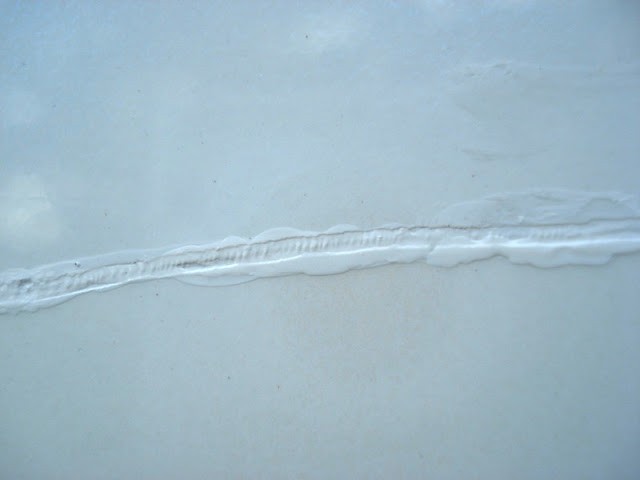 Applying base coat to car scratch repair area
Applying base coat to car scratch repair area - Drying Time: Allow each coat to dry for the recommended time (usually 12 hours between coats).
- Layering: Apply 3-4 coats for optimal coverage.
3.5. Step 5: Applying Clear Coat
- Clear Coat Application: Apply 2-3 coats of clear coat to protect the base coat and provide a glossy finish.
- Drying Time: Allow the clear coat to dry for at least 48 hours.
3.6. Step 6: Wet Sanding the Clear Coat
- Initial Wet Sanding: Use 2000-grit sandpaper to wet-sand the clear coat, removing any imperfections or orange peel texture.
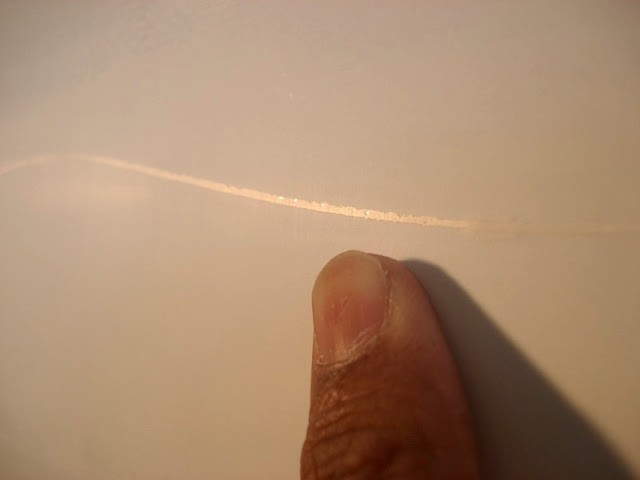 Wet sanding car clear coat with 2000 grit sandpaper
Wet sanding car clear coat with 2000 grit sandpaper - Progressive Sanding: Follow with 3000-grit sandpaper for a smoother finish.
3.7. Step 7: Compounding and Polishing
- Compounding: Apply rubbing compound to a foam pad and use a polishing machine to remove sanding marks and blend the repaired area with the surrounding paint.
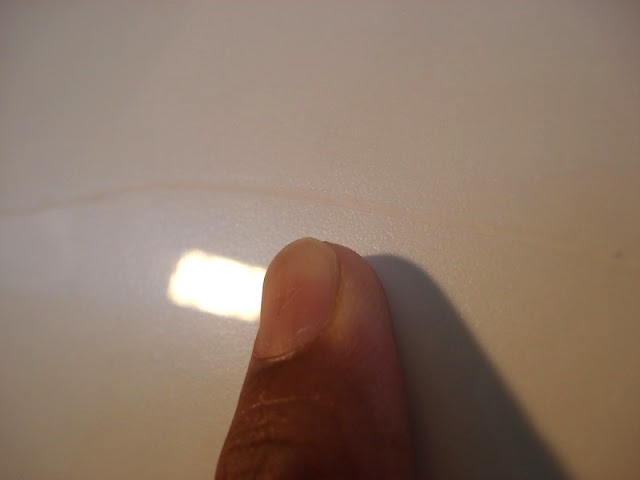 Compounding car scratch repair area with polishing machine
Compounding car scratch repair area with polishing machine - Polishing: Switch to a polishing pad and polishing compound to refine the finish and enhance the gloss.
- Final Polish: Finish with a microfiber pad and a fine polishing compound for a swirl-free shine.
3.8. Step 8: Applying Wax or Sealant
- Wax Application: Apply a coat of high-quality car wax or sealant to protect the repaired area and enhance its shine.
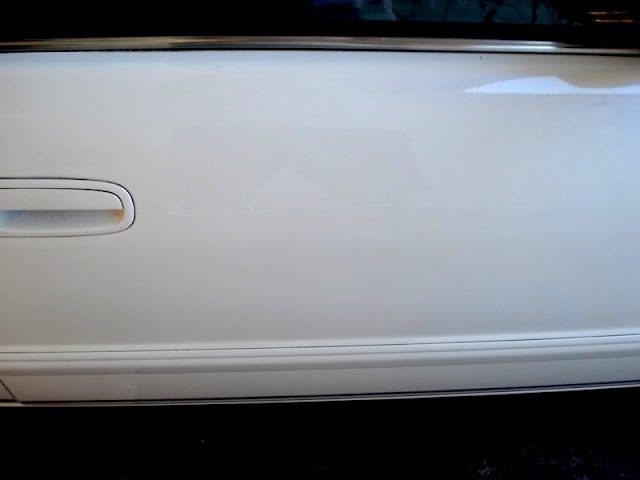 Applying car wax to repaired scratch area
Applying car wax to repaired scratch area - Buffing: Buff the wax with a clean microfiber towel for a glossy, protected finish.
4. Advanced Techniques for Challenging Scratches
Some deep scratches may require advanced techniques to achieve a flawless repair.
4.1. Dealing with Scratches that Reach the Metal
If the scratch has penetrated to the bare metal, it is essential to treat the area with a rust converter before applying primer. This prevents corrosion from forming under the paint.
4.2. Using Touch-Up Paint Effectively
For small, deep scratches, touch-up paint can be an effective solution. Apply the paint in thin layers, allowing each layer to dry completely before applying the next. Use a fine-tipped brush or paint pen for precise application.
4.3. Blending Techniques for Seamless Repairs
Blending is crucial for achieving a seamless repair. Use a blending solvent to soften the edges of the new paint, allowing it to blend seamlessly with the surrounding paint.
5. Common Mistakes to Avoid When Repairing Deep Scratches
Avoiding common mistakes can save you time and ensure a professional-quality repair.
5.1. Rushing the Process
Rushing any step of the repair process can lead to unsatisfactory results. Allow adequate drying time for each coat of paint and take your time during sanding and polishing.
5.2. Applying Too Much Paint at Once
Applying too much paint at once can cause runs and drips. Apply thin, even coats and allow each coat to dry completely before applying the next.
5.3. Using the Wrong Tools or Materials
Using the wrong tools or materials can damage your car’s paint. Always use high-quality automotive paint products and the correct sandpaper grit for each step.
5.4. Skipping Safety Precautions
Skipping safety precautions can expose you to harmful chemicals and debris. Always wear gloves, safety glasses, and a respirator when working with automotive paint products.
6. Maintaining Your Car’s Paint to Prevent Future Scratches
Preventing scratches is easier than repairing them. Follow these tips to maintain your car’s paint and minimize the risk of future damage.
6.1. Regular Washing and Waxing
Wash your car regularly to remove dirt and debris that can cause scratches. Wax your car every 2-3 months to protect the paint and provide a glossy finish.
6.2. Using Protective Coatings
Consider applying a ceramic coating or paint protection film to your car. These coatings provide a durable barrier against scratches, UV rays, and other environmental contaminants.
6.3. Safe Parking Practices
Park your car in covered areas whenever possible to protect it from the elements. Avoid parking near trees or bushes that can scratch the paint.
6.4. Careful Driving Habits
Drive carefully on gravel roads and avoid tailgating other vehicles. Use mud flaps to protect your car from rocks and debris.
7. The Science Behind Automotive Paint Repair
Understanding the science behind automotive paint repair can help you achieve better results.
7.1. Understanding Paint Layers
Automotive paint typically consists of several layers:
- Clear Coat: Provides a glossy finish and protects the underlying layers.
- Base Coat: Contains the color pigments.
- Primer: Promotes adhesion and provides a smooth surface for the base coat.
- Metal: The underlying body panel.
7.2. How Sandpaper Works
Sandpaper uses abrasive particles to remove imperfections from the paint surface. Different grit levels are used for different purposes, ranging from coarse sanding to fine polishing.
7.3. The Chemistry of Paint Products
Automotive paint products contain various chemicals that affect their performance. Understanding these chemicals can help you choose the right products for your repair.
8. Real-World Examples of Deep Scratch Repairs
Seeing successful deep scratch repairs can inspire confidence and provide practical insights.
8.1. Case Study 1: Repairing a Key Scratch
A car owner found a deep key scratch running along the side of their vehicle.
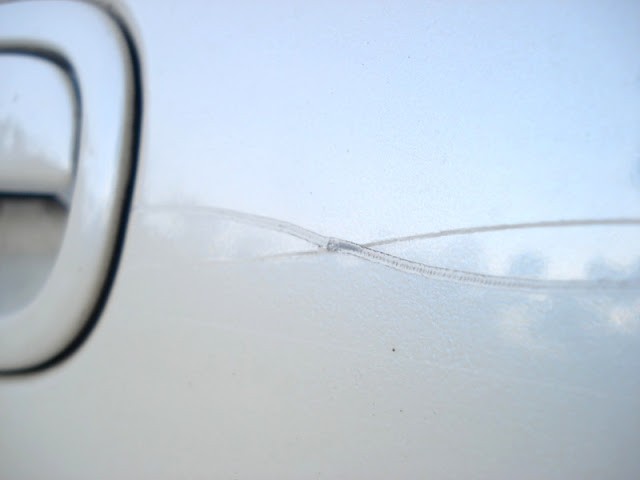 Deep key scratch on car doorThe scratch penetrated through the clear coat and base coat, exposing the primer.
Deep key scratch on car doorThe scratch penetrated through the clear coat and base coat, exposing the primer.
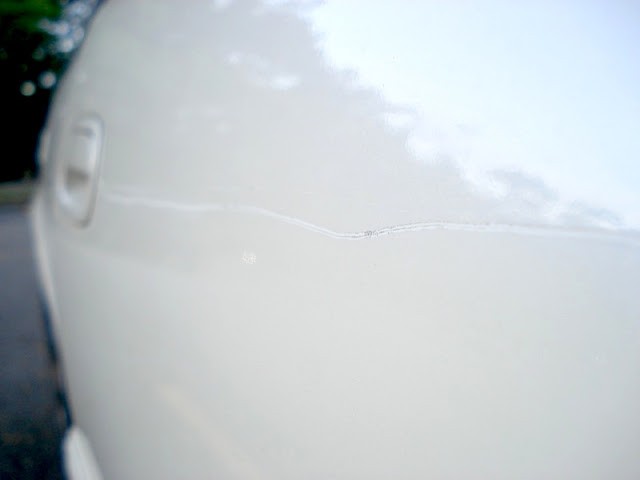 Close up of deep key scratch on carFollowing the steps outlined in this guide, the owner was able to successfully repair the scratch, restoring the car’s appearance.
Close up of deep key scratch on carFollowing the steps outlined in this guide, the owner was able to successfully repair the scratch, restoring the car’s appearance.
8.2. Case Study 2: Fixing a Scratch from a Branch
A car owner encountered a deep scratch from a tree branch while driving off-road. The scratch was deep and unsightly, but the owner was able to repair it using the techniques described in this guide.
8.3. Before and After Photos
Before-and-after photos can illustrate the dramatic improvement that can be achieved through deep scratch repair.
 Before and after deep scratch repair on carThese examples demonstrate that with the right tools and techniques, anyone can successfully repair deep scratches on their car.
Before and after deep scratch repair on carThese examples demonstrate that with the right tools and techniques, anyone can successfully repair deep scratches on their car.
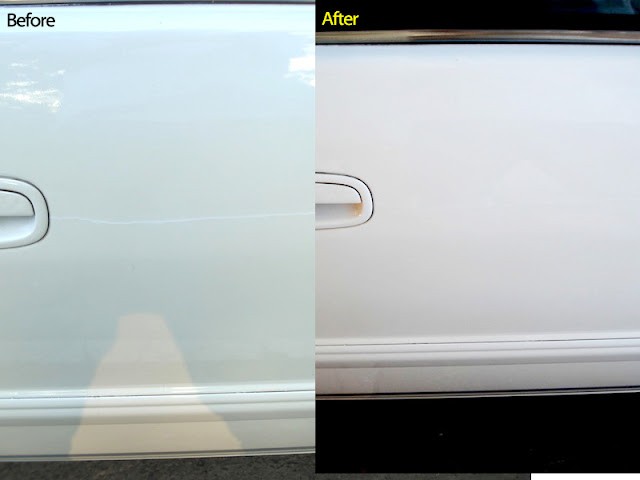 Before and after deep scratch repair on car
Before and after deep scratch repair on car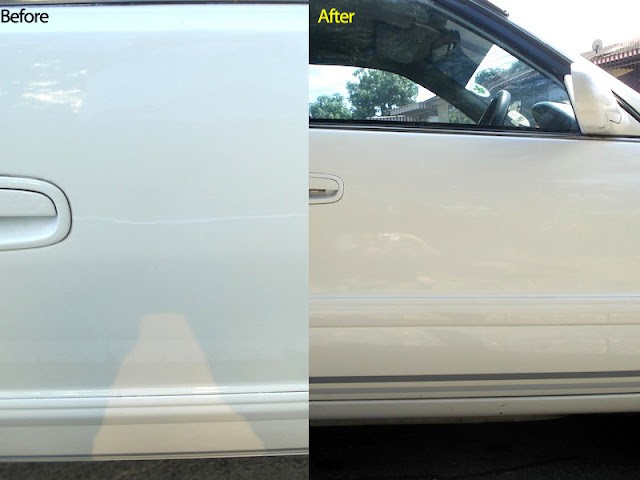 Before and after deep scratch repair on car
Before and after deep scratch repair on car
9. The Role of CARDIAGTECH.BIZ in Your Repair Journey
CARDIAGTECH.BIZ is your trusted partner for high-quality automotive repair tools and materials. We offer a wide range of products to help you achieve professional-quality results.
9.1. Our Commitment to Quality
At CARDIAGTECH.BIZ, we are committed to providing our customers with the highest quality tools and materials. We source our products from leading manufacturers and test them to ensure they meet our strict standards.
9.2. Product Recommendations for Deep Scratch Repair
We recommend the following products for deep scratch repair:
- Automotive Sandpaper: Available in various grits to suit your needs.
- Automotive Primer: Provides excellent adhesion and a smooth surface.
- Automotive Base Coat: Matches your car’s color code for a seamless repair.
- Automotive Clear Coat: Protects the base coat and provides a glossy finish.
- Polishing Machines: Rotary and dual-action models available.
- Buffing Pads: Foam and microfiber pads for compounding and polishing.
9.3. Contact Us for Expert Advice
If you have any questions or need assistance with your deep scratch repair, please contact us at +1 (641) 206-8880. Our expert team is here to help you every step of the way. You can also visit our website at CARDIAGTECH.BIZ or visit our location at 276 Reock St, City of Orange, NJ 07050, United States.
10. Conclusion: Achieving a Flawless Finish
Repairing deep scratches on your car can be a rewarding experience. By following the steps outlined in this guide and using high-quality tools and materials from CARDIAGTECH.BIZ, you can achieve a flawless finish and restore your car’s appearance.
10.1. Recap of Key Steps
- Clean the area thoroughly.
- Sand the scratch with progressively finer grits of sandpaper.
- Apply primer, base coat, and clear coat.
- Wet-sand the clear coat to remove imperfections.
- Compound and polish the repaired area.
- Apply wax or sealant to protect the finish.
10.2. Long-Term Benefits of Proper Repair
Properly repairing deep scratches can prevent rust and corrosion, maintain your car’s value, and enhance its appearance. It also saves you money in the long run by preventing more extensive repairs.
10.3. Call to Action: Contact CARDIAGTECH.BIZ Today
Ready to get started on your deep scratch repair? Contact CARDIAGTECH.BIZ today at +1 (641) 206-8880 for expert advice and high-quality tools and materials. Visit our website at CARDIAGTECH.BIZ or stop by our location at 276 Reock St, City of Orange, NJ 07050, United States. Let us help you achieve a flawless finish and keep your car looking its best.
FAQ: Frequently Asked Questions About Deep Scratch Repair
1. What is the best way to fix deep scratches on a car?
The best way to fix deep scratches involves cleaning, sanding, applying primer, base coat, and clear coat, wet sanding, compounding, and polishing. This multi-step process ensures a seamless and durable repair.
2. Can I fix a deep scratch on my car myself?
Yes, you can fix a deep scratch on your car yourself with the right tools, materials, and techniques. This guide provides a comprehensive step-by-step approach to help you achieve professional-quality results.
3. How much does it cost to fix a deep scratch on a car?
The cost to fix a deep scratch on a car can range from $100 to $500 or more, depending on the size and depth of the scratch, the type of paint, and whether you hire a professional or do it yourself. Doing it yourself can significantly reduce the cost.
4. What tools do I need to fix a deep scratch?
You will need car wash soap, microfiber towels, detailing clay bar, sandpaper (800, 1200, 2000, 3000 grit), a sanding block, automotive primer, base coat, clear coat, paint thinner, touch-up applicators, rubbing compound, polishing compound, buffing pads, a polishing machine, masking tape, gloves, safety glasses, and a respirator.
5. How do I match the paint color for my car?
To match the paint color for your car, locate the paint code on the vehicle (usually on the driver’s side doorjamb or in the engine compartment). Use this code to purchase the correct base coat from an automotive paint supplier like CARDIAGTECH.BIZ.
6. How long does it take to fix a deep scratch on a car?
Fixing a deep scratch on a car can take several hours to several days, depending on the complexity of the repair and the drying time required for each coat of paint. Proper preparation and patience are key.
7. What is wet sanding, and why is it important?
Wet sanding involves using sandpaper with water or a lubricant to smooth the paint surface and remove imperfections. It is important because it prevents the sandpaper from clogging and reduces the risk of scratching the paint.
8. Can I use touch-up paint for deep scratches?
Yes, touch-up paint can be used for small, deep scratches. Apply the paint in thin layers, allowing each layer to dry completely before applying the next. Use a fine-tipped brush or paint pen for precise application.
9. How do I prevent future scratches on my car?
To prevent future scratches, wash your car regularly, wax it every 2-3 months, use protective coatings like ceramic coatings or paint protection film, park in covered areas, and practice careful driving habits.
10. Where can I buy high-quality tools and materials for car scratch repair?
You can buy high-quality tools and materials for car scratch repair at CARDIAGTECH.BIZ. We offer a wide range of products, including sandpaper, primer, base coat, clear coat, polishing machines, and buffing pads. Contact us at +1 (641) 206-8880 or visit our website at CARDIAGTECH.BIZ.



